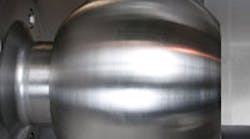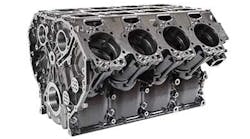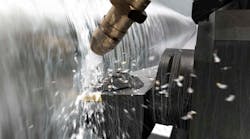There are pluses and minuses to working in the machine shop at MOGAS Severe Service Ball Valves. On the plus side, there’s plenty of work despite the ongoing economic uncertainties; as part of a global corporation, the Houston-based process valve manufacturer is busier than ever. The backlog of orders is so extensive that the CNC department and manual machine shop must run 24/7 just to keep up.
On the other hand, to fill all those orders MOGAS must machine a lot of “uncooperative” Inconel 718. That heat-resistant alloy is notorious for burning up tools and generating long, stringy chips with a proclivity for adhering to cutting edges. This limits cutting rates and necessitates frequent but unpredictable stoppages for indexing — considerably upsetting that round-the-clock schedule.
Last August, MOGAS CNC programmer/supervisor Zach Horton and his CNC team, together with Ingersoll’s Craig Kippola, attacked the problem head-on by seeking to find a faster, more reliable way to machine that most contentious material. As a result, they’re turning Inconel 718 valve balls four times faster than with carbide — and twice as fast as with any other ceramic they’ve ever tried. Similarly, the team improved rough milling rates by 5 to 1 over carbide, and again, 2 to 1 versus any other ceramic.
And there was a ripple effect, too: Once the Inconel parts ran better, so did the entire machine shop.
Four-part solution
There were four parts to their solution: 1) retool with an Ingersoll ceramic insert, with special edge preparation; 2) inject some “out of the box” programming; 3) sacrifice edge life for exponential gains in feeds and speeds as a matter of strategy; 4) and control process heat to speed up edge indexing.
The principal parts in MOGAS ball valves are the balls and their mating valve seats. Such valves help control hot, corrosive process fluids found in refining, chemical and mining operations. Each valve has one ball and two valve seats that require precision machining for the valve to be truly leak-proof. The ball has a bore down its center, rotating the ball opens and closes the flow of material.
MOGAS makes the balls from chucked barstock: Bore out the main bore, mount it on a mandrel, turn the OD, then move the piece to another machine to pocket-mill a rectangular slot. The slots engage the valve stem as part of the rotation mechanism. The valve seats involve OD and ID turning only, with the ID a spherical radius to mate with the ball.
Commitment to ceramics
Together with lead man Hub Whitley, Zach settled on ceramic tooling to replace the carbide components. They tried a few grades on their own and achieved 50% to 100% productivity improvements, but edge failures were so unpredictable that they defeated process stability. So, they called Ingersoll’s Craig Kippola and Kirk Higby of tooling distributor Cutting Tools Inc. for specific recommendations on grades and machining parameters. “They solved past problems for us very well, so they were the natural ‘go-to guys’ this time around,” said Horton.
Kippola’s recommendation for both turning and milling: Ingersoll ceramic grade AS20 SiN inserts, running at roughly twice the speed of any other ceramic tried. To Horton’s surprise, the inserts were “unwhiskered” (no microscopic reinforcing fibers), with special edge preparation. Turning inserts are plain rounds, which rough at 1,200 SFM. Milling inserts, seated in a 2-inch shell mill, are notched for better gripping in the seat pocket to withstand the extremely fast rpm’s. Standard speed: 2,500 SFM.
“Many people think that whiskered ceramics are intrinsically tougher than unwhiskered ones, but that’s ‘old school’,” said Kippola. “Newer, unsupported ceramics exhibit vastly improved toughness because of the substrates themselves.”
Faster machining, reliably
In initial trials, the Ingersoll solution achieved slightly higher rates than other ceramics, but did so with much more reliability. Failure causes were edge wear (which was very predictable), not edge rupture (which is not.) “Performance was especially impressive on milling, with its interrupted cuts that often fracture brittle ceramics,” said Hub Whitley.
Once the requisite stability was established, the MOGAS CNC team modified the programs for more aggressive toolpaths, and then turned to Kippola and Higby to optimize the final machining parameters. The critical detail of their strategy was to push machining rates, even at the expense of edge life. “Sure, ceramic inserts aren’t cheap, but the real potential for money saving is to speed up the chipmaking and let the rest fall where it may,” said Horton.
The outcome: a secure process for roughing Inconel, which runs twice as fast as with any other ceramic. For example, turning a ball that used to take an entire shift with carbide, and two hours with other ceramics, now takes an hour. A seat ring that once took an hour with carbide, and 30 minutes with other ceramics, is now completed within 15 minutes.
Some milling jobs feed at 200 IPM @ 2,500 SFM without catastrophic edge failure. Turning feeds up to 0.01 IPR @ 1,200 SFM are routine. “With the other ceramics we tried, whiskered or unwhiskered, the milling was not up to our standards,” said Hub Whitley.
Ceramic, but built for roughing
A key factor in the performance of the Ingersoll AS20 ceramic is the toughness of the SiN substrate, combined with a very strong geometry and special edge prep. Unlike most ceramics, the AS20 is designed specifically for roughing, and in particular features a wide land. Top-face geometry puts more of the machining heat into the departing chip than into the tool, toolholder, or workpiece. This not only protects the insert, but also helps speed up indexing.
Dispensing with the whiskers also reduced insert costs compared with all the others that the MOGAS CNC team considered.
Indeed, heat management in a broader sense helped to shorten cycle times in other ways. Keeping the tools just warm to the touch will shorten indexing downtime to a measurable degree. “We’re deliberately accepting high edge wear in exchange for higher throughput, which necessarily means more frequent indexing,” says Horton. “Naturally we want to avoid indexing delays due to inserts becoming too hot to handle right away.” Kippola added that he has seen processing at other plants delayed for 10 minutes or more, waiting for the tool to cool off enough to handle.
Accordingly, MOGAS flood cools everything during turning ---work piece, mandrel, tool and tool holder. They run the milling dry, but flood the cutter and inserts for 15 seconds at every indexing stoppage. Horton won’t disclose the actual indexing frequency, but says it’s short enough to shock some people. “Nevertheless, we’re way ahead economically by burning through inserts in order to run faster. That’s a trade-off I’d take any day.”
Based on success with the Inconel balls and seats, Horton is running the same Ingersoll ceramic insert to turn valve stems, and is doing a considerable volume of boring, too. “We’re pushing the envelope regarding boring Inconel with ceramics, with excellent results” says Horton. “We’ve heard that many shops avoid boring Inconel with ceramic inserts because the material doesn’t tolerate the recutting very well. With this particular Ingersoll grade and special attention to chip evacuation, our boring operations have been very successful.”








